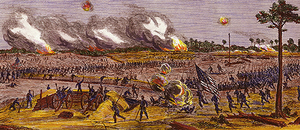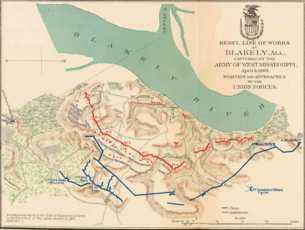Battle of Fort Blakeley
30°44′32.67″N 87°55′37.34″W / 30.7424083°N 87.9270389°W
| Battle of Fort Blakeley | |||||||
|---|---|---|---|---|---|---|---|
| Part of the American Civil War | |||||||
 Storming of Fort Blakeley | |||||||
| |||||||
| Belligerents | |||||||
|
|
| ||||||
| Commanders and leaders | |||||||
|
Edward Canby Frederick Steele | St. John R. Liddell | ||||||
| Units involved | |||||||
|
Army of West Mississippi, Union ships |
Fort Blakeley Garrison, Confederate ships | ||||||
| Strength | |||||||
| 45,000 [1] | 4,000 [1] | ||||||
| Casualties and losses | |||||||
| 629 on April 9 (150 killed, 650 wounded total[2]) | 2,900 (75 killed[2]) | ||||||
The Battle of Fort Blakeley took place from April 2 to April 9, 1865 in Baldwin County, Alabama, about 6 miles (9.7 km) north of Spanish Fort, AL, as part of the Mobile Campaign of the American Civil War. At the time, Blakeley, Alabama had been the county seat of Baldwin County.[3]
The Battle of Blakeley was the final major battle of the Civil War, with surrender just hours after Grant had defeated Lee at Appomattox on the morning of April 9, 1865.[2] Mobile, Alabama was the last major Confederate port to be captured by Union forces, on April 12, 1865.[3] After the assassination of President Lincoln on April 15, 1865, other Confederate surrenders continued into May 1865.
Course of the battle


Maj. Gen. Edward Canby's Union forces, the XVI and XIII Corps,[4][3] moved along the eastern shore of Mobile Bay, forcing the Confederates back into their defenses. Union forces then concentrated on Spanish Fort, Alabama and nearby Fort Blakeley. By April 1, Union forces had enveloped Spanish Fort, thereby releasing more troops to focus on Fort Blakeley. Union forces built 3 rings of earthworks reaching ever closer until nearly 1,000 yards (910 m) from the Fort Blakely front.[3] Confederate Brig. Gen. St. John R. Liddell, with about 4,000 men, held out against the much larger Union force until Spanish Fort fell on April 8 in the Battle of Spanish Fort. This allowed Canby to concentrate 16,000 men for the attack on April 9, led by Brig. Gen. John P. Hawkins. Sheer numbers breached the Confederate earthworks, compelling the Confederates, including Liddell, to surrender within about 30 minutes in the final assault after 5:30 pm.[2]
The casualty figures are approximate, but an estimated 75 Confederate soldiers were killed, with over 2,800 captured, and 150 Union troops were killed with 650 wounded during the siege and assault.[2] The siege and capture of Fort Blakeley was basically the last combined-force battle of the war. Yet, it is criticized by some (such as Ulysses S. Grant) as an ineffective contribution to Union war effort due to Canby's lateness in engaging his troops. The battle was actually fought hours after the Confederate General Robert E. Lee surrendered at Appomattox. The battle is considered the last major battle of the Civil War[5][2] with the exception of the Battle of Columbus, Georgia, fought a few days later. African-American forces played a major role in the successful Union attack, with 5,000 colored troops of the Union U.S.C.T. brought through Pensacola, FL.[3]
Two days later, the 2 nearby island batteries in the Blakeley River were abandoned.[2] After this battle, Union forces were finally able to occupy the city of Mobile, Alabama on April 12, 1865.[2]
Legacy
The site of the battle is now a historical park, Historic Blakeley State Park. The Civil War Trust, a division of the American Battlefield Trust, has saved 67 acres of Fort Blakeley Battlefield in partnership with the Historic Blakeley Foundation.[6]
Opposing forces
Union
Confederate
Notes
- ^ a b Bodart (1908), p.542
- ^ a b c d e f g h "Battle of Fort Blakeley". EncyclopediaOfAlabama.org. 2017. p. 1, paragraph 7. Retrieved 2017-11-07.
- ^ a b c d e Mike Bunn, Historic Blakeley State Park (May 2017). "Battle of Fort Blakeley". Encyclopedia of Alabama. Retrieved 2017-11-07.
- ^ "Battle of Blakeley". Historical Marker Database. Retrieved 24 September 2015.
- ^ Anderson, Marc D. (March 26, 2015). "Re-enactors to fire up Civil War battlefield Saturday, marking 150th anniversary of Battle of Fort Blakeley". AL.com. Retrieved March 26, 2015.
- ^ [1] Land Saved by the American Battlefield Trust, accessed May 18, 2018.
References
- Bodart, Gaston (1908). Militär-historisches kreigs-lexikon, (1618-1905). Stern.
- National Park Service CWSAC Battle Summary
- Update to the Civil War Sites Advisory Commission Report on the Nation's Civil War Battlefields - State of Alabama
- Silkenat, David. Raising the White Flag: How Surrender Defined the American Civil War. Chapel Hill: University of North Carolina Press, 2019. ISBN 978-1-4696-4972-6.
External links
 Media related to Battle of Fort Blakely at Wikimedia Commons
Media related to Battle of Fort Blakely at Wikimedia Commons- Jordan, Daniel W. III (2019). "Operational Art and the Campaign for Mobile, 1864-1865: A Staff Ride Handbook" (PDF). Fort Leavenworth, Kan.: Combat Studies Institute Press, US Army Combined Arms Center. ISBN 9781940804545. Retrieved June 12, 2020.
{{cite web}}: Invalid|ref=harv(help) - The Battle of Fort Blakley: Battle Maps, History Articles, Photos, and Preservation News (CWPT)
- Mobile campaign (1865)
- Battles of the Lower Seaboard Theater and Gulf Approach of the American Civil War
- Union victories of the American Civil War
- Sieges of the American Civil War
- Battles of the American Civil War in Alabama
- Baldwin County, Alabama
- 1865 in the American Civil War
- 1865 in Alabama
- African Americans in the American Civil War
- April 1865 events
